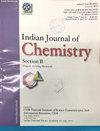Antimicrobial activity of 7,3ʹ,4ʹ-trihydroxyflavonol isolated from Acacia nilotica var. ad stringens
IF 0.5
4区 化学
Q3 Pharmacology, Toxicology and Pharmaceutics
Indian Journal of Chemistry Section B-organic Chemistry Including Medicinal Chemistry
Pub Date : 2021-10-07
DOI:10.56042/ijcb.v60i8.29194
引用次数: 0
Abstract
Acacia species (Mimosaceae) is widely distributed in tropical and subtropical countries and has a variety of ethnomedicinal uses. There is inadequate laboratory investigation to identify bioactive compounds and therapeutic effect of Acacia nilotica var. adstringens. This research was conducted to extract, isolate and identify major compounds from heartwood of Acacia nilotica var. adstringens and to test them against representative bacteria. Powdered air-dried heartwood of A. nilotica var. adstringens was extracted with methanol/water, 4:1 and the extracted was then purified using chromatographic techniques (column and paper chromatography). A pure flavonoid compound was isolated and the structure was elucidated based on extensive spectroscopic analysis procedures (IR, UV, 1H-NMR, and MS spectrometery). The isolated compound was then evaluated for antimicrobial potential against Gram-negative (Escherichia coli and Pseudomonas aeruginosa) and Gram-positive bacteria (Bacillus subtilis, Bacillus cereus, and Staphylococcus aureus) using cub-plate agar diffusion method. The spectroscopic analysis of the isolated compound led to its identification as 7, 3`, 4`-trihydroxyflavonol. The compound showed varying antimicrobial responses with high potency against Gram-negative human pathogens. The Gram-positive bacteria which were inhibited were Bacillus cereus, Corynebacterium sp., Enterococcus faecalis, Staphylococcus aureus, and Streptococcus agalactiae. The Gram-negative bacteria were Acinetobacter baumannii, Acinetobacter sp., Escherichia coli, Pseudomonas aeruginosa and yeasts were Candida albicans and Cryptococcus neoformans. The present study demonstrated that 7, 3`, 4`-trihydroxyflavonol is an effective antimicrobial compound. If applied in suitable pharmaceutical formulations it could be valuable for treating various bacterial infections or introduced as adjunct treatment along with standard agents.金合欢7,3′,4′-三羟基黄酮醇的抑菌活性研究
金合欢属(含羞草科)广泛分布于热带和亚热带国家,具有多种民族医药用途。目前还没有足够的实验室研究来鉴定金合欢的生物活性成分和治疗效果。本研究对阿拉伯合欢心材的主要成分进行了提取、分离和鉴定,并对其代表性细菌进行了抑菌试验。用甲醇/水比4:1的比例提取风干干心材粉末,用色谱技术(柱层析和纸层析)对提取物进行纯化。通过广泛的光谱分析(IR、UV、1H-NMR和MS)对其结构进行了鉴定。然后用平板琼脂扩散法评估分离的化合物对革兰氏阴性菌(大肠杆菌和铜绿假单胞菌)和革兰氏阳性菌(枯草芽孢杆菌、蜡样芽孢杆菌和金黄色葡萄球菌)的抗菌潜力。化合物经光谱分析鉴定为7,3 ',4 ' -三羟基黄酮醇。该化合物对革兰氏阴性人类病原体表现出不同的抗菌反应。被抑制的革兰氏阳性菌为蜡样芽孢杆菌、棒状杆菌、粪肠球菌、金黄色葡萄球菌和无乳链球菌。革兰氏阴性菌为鲍曼不动杆菌、不动杆菌、大肠杆菌、铜绿假单胞菌,酵母菌为白色念珠菌和新生隐球菌。本研究表明,7,3 ',4 ' -三羟基黄酮醇是一种有效的抗菌化合物。如果应用在合适的药物制剂中,它可用于治疗各种细菌感染或作为辅助治疗与标准制剂一起引入。
本文章由计算机程序翻译,如有差异,请以英文原文为准。
求助全文
约1分钟内获得全文
求助全文
来源期刊
自引率
0.00%
发文量
1
审稿时长
4-8 weeks
期刊介绍:
Indian Journal of Chemistry (Section B) is a leading monthly journal in Organic and Medicinal Chemistry started publishing from 1976. It publishes papers on organic reaction mechanism, theoretical organic chemistry, structure-activity relationships, medicinal chemistry, synthesis of chiral compounds, bio-organic chemistry, enzymes in organic synthesis, reagents in organic synthesis, heterocyclic compounds, phytochemistry (natural products), amino acids, peptides and proteins, spectroscopy in characterization of organic compounds, chemoenzymatic and enantioselective synthesis of organic compounds, synthesis of fullerenes, metal-catalyzed asymmetric reactions, bioactive plant products and combinatorial chemistry. Apart from full length papers, notes and communications, the journal publishes short reviews on frontline areas under the column " advances in Contemporary Research".

 求助内容:
求助内容: 应助结果提醒方式:
应助结果提醒方式:


